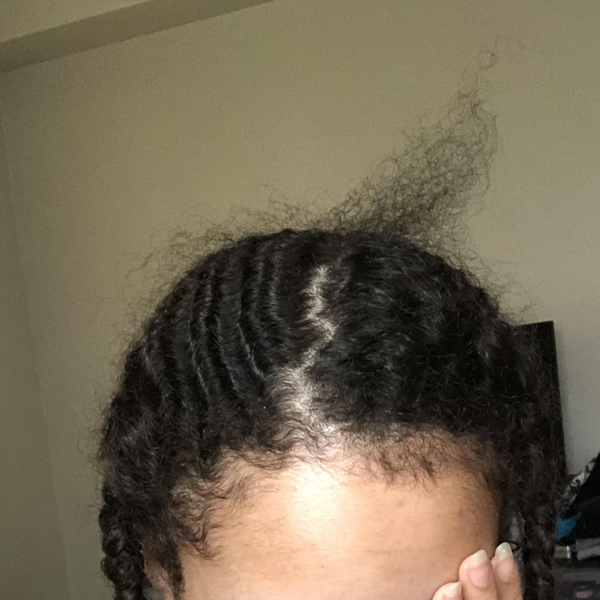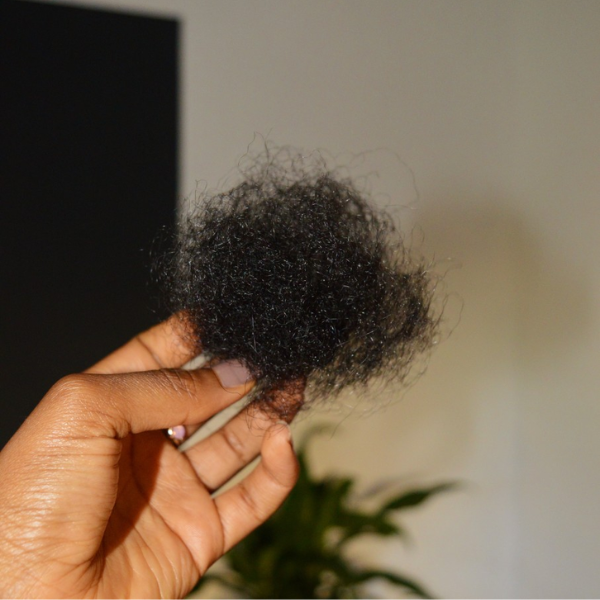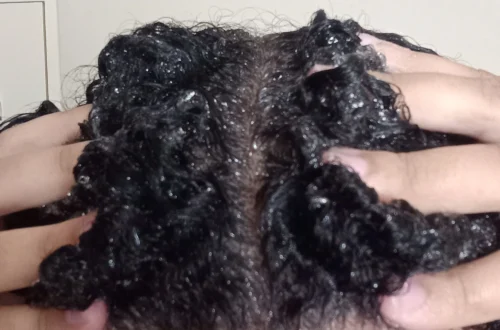Is Your Hair Shedding Or Is It Breakage, The Real Difference

Are you experiencing excessive shedding and finding yourself constantly asking, “Why is my natural hair shedding so much?” or is it actually natural hair breakage?
You’re not alone, trust me. Shedding is a natural part of the hair growth cycle, but when it becomes excessive hair shedding, it can be concerning.
In this blog post, we’ll go into the various factors that contribute to excessive hair loss in natural hair, from the role of hair follicles to the impact of protective styles and everything in between.
Understanding the Hair Growth Cycle:
To understand why your natural hair may be shedding excessively, it’s important to understand the hair growth cycle.
This cycle consists of three phases: the anagen phase (the growing phase), the catagen phase (the transitional phase), and the telogen phase (the resting phase), damn how many times am I gonna say phase.
Shedding happens during the telogen phase when old strands of hair are shed to make way for new ones.
In the final stage, aka the shedding stage, your hair falls from your scalp.
This can happen naturally, but you may notice more of it when brushing, washing or styling your hair. That’s simply because of how the manipulation encourages the shedding that’s already happening.
However, when the shedding surpasses the normal amount, and it becomes excessive hair shedding it may indicate an underlying issue.
The Difference Between Shedding and Breakage
Firstly, you need to be familiar with what shedding and breakage is.
Natural hair breakage and hair shedding are sometimes used interchangeably to explain the loss of hair, but they are different.
Shedding is a natural part of your hair cycle.
You’re supposed to lose hair daily — anywhere from 50 to 100 hairs a day, that’s the normal, you should expect that, but if you’re noticing rapid thinning or a lack of new hair growth, then there’s cause for concern.
Hair breakage, on the other hand, happens when the actual strand breaks.
Breakage describes what happens when a hair strand snaps under tension that it can’t withstand.
You lose part of the length of that strand, with part of the strand remaining on your scalp.
You can easily distinguish breakage from hair loss or shedding because broken hairs will be shorter than the normal length of your hair.
Most times, you won’t notice full hairs on your brush but instead little pieces of hair, that is not shed hair, that is breakage.
Split ends are a sign of hair breakage that needs to be trimmed to keep the strand from tearing up to the root.
Understanding the distinction between shedding and breakage is important in addressing your hair concerns effectively.
Where and how hair breaks depend on several different factors, more on that here.
Is It Shedding Or Hair Loss?

Hair shedding and hair loss may seem similar, but they actually differ in their causes and implications for your curls.
Shedding, a natural process, occurs as part of your hair’s regular cycle.
It’s a normal occurrence influenced by various factors like seasonal changes, age, hormonal fluctuations, and the natural rhythm of your hair follicles.
Shedding takes place during the exogen phase of the hair growth cycle, a brief period lasting 2-4 days, where old hair follicles are shed to make way for new growth.
According to the American Academy of Dermatology, individuals typically shed around 50-100 hairs per day, with curly hair types being more prone to shedding due to their structure.
However, considering the abundance of approximately 100,000 hair follicles on our heads, shedding a hundred hairs daily is a relatively minor amount in the grand scheme of things.
Hair loss, unlike shedding, is typically caused by conditions such as non-scarring alopecia or anagen effluvium.
These conditions involve inflammation or toxicity that leads to the fracturing of the hair shaft, hindering its growth.
In essence, hair loss indicates an underlying issue preventing your natural hair from growing properly, resulting in weakness or breakage of the hair shaft.
Unlike shedding, which is a natural part of the hair growth cycle, hair loss often stems from external factors.
A helpful guideline to distinguish between the two is that shedding is temporary, whereas hair loss tends to be long-term and may require intervention to address the underlying cause.
Common Reasons for Excessive Hair Shedding:
Traction Alopecia and Tight Hairstyles:
Tight hairstyles like braids, ponytails, or extensions can exert excessive tension on the hair follicles, leading to traction alopecia—a type of hair loss that results from prolonged pulling.
Dry Hair and Lack of Moisture:
Natural hair, especially curly hair, and kinky textures, tends to be prone to dryness.
With the lack of moisture, the hair shaft becomes brittle and prone to hair breakage, leading to excessive hair loss.
Heat Styling and Excessive Heat:
Flat irons, blow dryers, and other heat styling tools can cause damage to the hair shaft if used excessively or at high temperatures, leading to increased shedding.
Heat treatments in general are bad for your curly hair, so try to avoid it as much as possible and use heat protectant when you do heat styling.
Nutritional Deficiencies:
A balanced diet rich in essential nutrients, including protein, fatty acids, and vitamins, is crucial for healthy hair growth.
Nutritional deficiencies can disrupt the hair growth cycle and contribute to excessive shedding.
Hormonal Changes and Medical Conditions:
Hormonal fluctuations, autoimmune diseases like alopecia areata, and underlying medical conditions can disrupt the hair growth cycle and lead to excessive shedding.
Identify The possible causes of hair loss For You

If you’re experiencing excessive shedding, the first step is to identify the possible possible causes of hair loss.
Consider factors such as your hair care routine, heat styling or other styling techniques, stress levels, and overall health.
Keep an eye on your shower drain and bathroom floor for shed hairs, as well as any changes in the amount of hair you find during wash day.
Also, consider any underlying health conditions you may have that could possibly cause excessive hair loss.
How To Stop Excessive Shedding
Experiencing excessive shedding in your natural hair can be frustrating and concerning.
However, there are proactive steps you can take to address this issue and promote healthy hair growth:
Evaluate Your Hair Care Routine:
Start by assessing your current hair care routine.
Are you using the right products for your hair type?
Look for sulfate-free shampoos, moisturizing conditioners, and leave-in conditioners rich in natural oils like jojoba oil, which can help nourish and strengthen your hair strands.
Avoid products with harsh chemicals that can strip your hair of its natural oils and contribute to excessive shedding.
Minimize Heat Styling:
Reduce your reliance on heat styling tools like flat irons and blow dryers, as excessive heat can damage the hair shaft and lead to increased shedding.
Instead, opt for heatless styling methods or use heat protectant sprays when heat styling is unavoidable.
Opt for protective hairstyles:
Protective hairstyles, such as braids, or twists can help minimize manipulation and protect your hair from breakage.
Be mindful of protective styles like braids and twists—while they can help minimize manipulation, avoid styles that are overly tight and can cause traction alopecia.
Prioritize Moisture and Deep Conditioning:
Natural hair, especially curly hair, and kinky textures, tends to be dry hair, which can contribute to hair breakage and excessive shedding.
Make moisturizing a priority in your hair care routine by using a daily moisturizer and incorporating deep conditioning treatments into your regimen.
Look for deep conditioners that are formulated to replenish moisture loss and strengthen the hair shaft, promoting healthy hair growth.
Nourish Your Body with a Balanced Diet:
Nutrition plays a crucial role in the health of your hair follicles and the strength of your hair strands.
Ensure you’re consuming a balanced diet rich in protein, fatty acids, vitamins, and minerals essential for healthy hair growth.
Incorporate foods like fish, nuts, seeds, fruits, and vegetables into your meals to provide your body with the nutrients it needs to support strong, resilient hair.
Manage Stress and Prioritize Self-Care:
Stress can contribute to hormonal imbalances and disrupt the hair growth cycle, leading to excessive shedding.
Take steps to manage your stress levels through relaxation techniques such as meditation, yoga, or deep breathing exercises.
Prioritize self-care activities that bring you joy and relaxation, whether it’s spending time outdoors, practicing hobbies, or connecting with loved ones.
Be gentle when handling your hair:
Treat your hair with care to avoid unnecessary hair breakage and excessive shedding.
Avoid aggressive brushing or styling, and use wide-toothed combs or your fingers to detangle your hair gently.
When drying your hair, use a microfiber towel or an old t-shirt to blot out excess moisture instead of rubbing vigorously with a regular towel.
Fighting off excessive shedding in natural hair requires a holistic approach that addresses both external and internal factors.
By evaluating your hair care routine, minimizing heat styling and tight hairstyles, prioritizing moisture and deep conditioning, nourishing your body with a balanced diet, and managing stress levels, you can take proactive steps to promote healthier hair growth and reduce shedding.
Remember, consistency is key, so stick to your new hair care habits and be patient as you observe improvements in the health of your hair.
The Importance of Protective Styling and Hair Care:
While protective styles like braids and twists can help minimize manipulation and breakage, it’s essential to strike a balance.
Avoid hair styles that are overly tight or put excessive strain on your hair follicles.
Additionally, prioritize a healthy hair care routine that includes deep conditioning treatments, regular moisturization, and gentle handling of your hair.
When you remove a protective style, expect a lot of shedding, it is no cause for concern.
Because your hair has been shedding while it was in this protective style, the hairs have been trapped. So you’re not losing any of this hair, it’s just finally being released.
Seeking Professional Help:

If you’ve tried adjusting your hair care routine and lifestyle habits without success, it may be time to seek professional help.
A dermatologist or trichologist can conduct a thorough examination, perform relevant tests such as blood tests to check for nutritional deficiencies or hormonal imbalances, and provide personalized recommendations for addressing your excessive shedding.
Excessive shedding in natural hair can be distressing, but understanding the underlying causes and implementing appropriate solutions can help restore the health of your hair.
You should seek support from a dermatologist or another healthcare professional if you notice:
- Sudden bald spots or thin patches of hair
- Full hairs that shed or fall out in multiple strands or clumps
From avoiding tight hairstyles to nourishing your hair with natural oils and maintaining a balanced diet, taking proactive steps can make a significant difference.
Remember, each strand of hair is precious, so treat it with care and seek professional guidance when needed for the best results.
Pin For Later!








